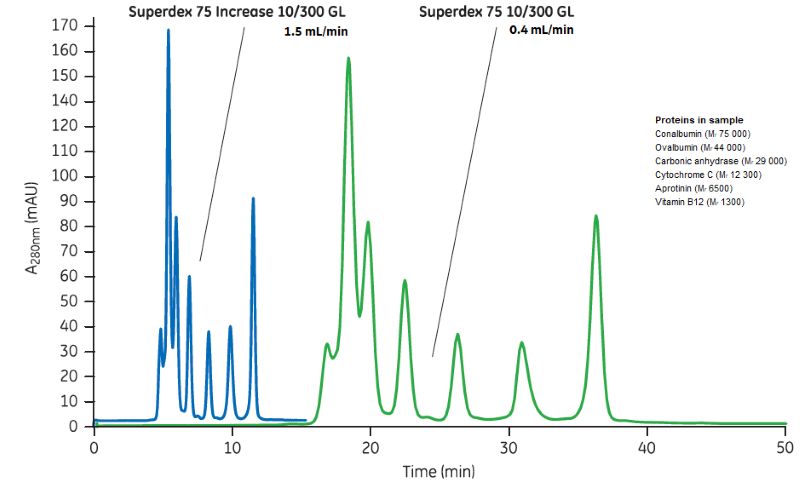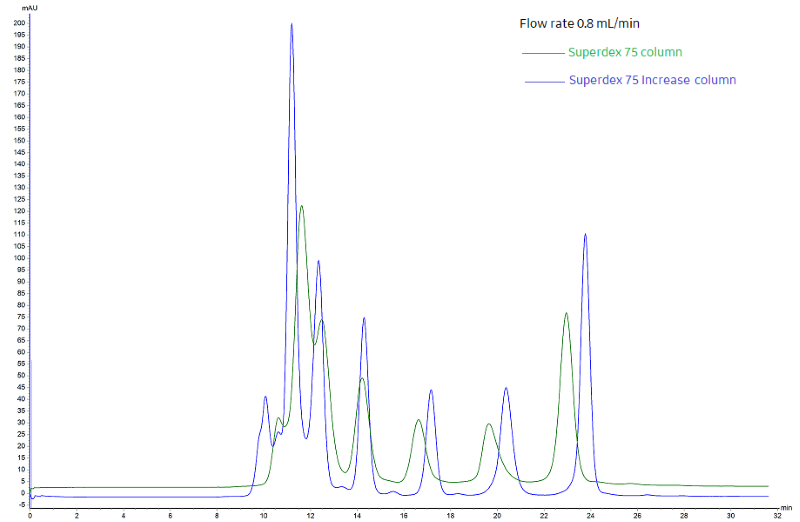You may have heard about our new generation of agarose-based size exclusion chromatography (SEC) columns. But are you wondering why they are named “Increase”? I think the answer to this question will be clear after you see some data from the newest member of the family, Superdex 75 Increase.
A key characteristic of agarose is behind this innovation
Like many of GE’s resins, the ones inside our “Increase” columns are based on agarose. There are several reasons we really like agarose. One of these, the ability to create rigid beads, is the basis for the performance enhancements provided by our “Increase” columns compared with the previous version columns. Read on to learn how this property translates into results.
Reason #1. Increase time savings by running faster
Parallel SEC runs were performed on a Superdex 75 Increase column and its predecessor column, Superdex 75. Flow rate was the only variable. A 100 µL sample containing a mixture of six proteins from molecular weights Mr 1300 to 75 000 was applied to each 10 x 300 mm column. Both runs were performed on our ÄKTA pure 25 protein purification system. The flow rate for the “Increase” column was 1.5 mL/min, which was more than three times faster than the 0.4 mL/min flow rate for the legacy column. The results are provided in the following chromatogram.

The resolution for the Superdex 75 Increase column is similar to that of the legacy column, but it is difficult to see on this image with its shared time axis. The separate chromatograms for each column can be viewed in the data file for Superdex 75 Increase.
These results demonstrate that the more rigid beads of the resin inside this new generation column allow faster flow rates without compromising resolution.
Reason #2. Increase resolution that can be achieved
A similar set of parallel runs was performed as in the previous experiment. In this instance there were no variables. Both 10 x 300 mm columns were loaded with a 100 µL sample containing the same mixture of six proteins as in the prior example. Both runs were performed on our ÄKTA pure 25 chromatography system. The flow rate of both columns was 0.8 mL/min. The following overlay chromatogram shows the results for the Superdex 75 Increase column (in blue) combined with those for the legacy column (in green).

An increase in resolution of 40%–120% was achieved on the Superdex 75 Increase column compared with the legacy column. Note that increased resolution gives higher peaks, with higher concentrations. The individual chromatograms for these two runs are provided in the Superdex 75 Increase data file.
The higher resolution for the Superdex 75 Increase column compared with the legacy column is enabled by a combination of the smaller bead size and a narrower particle size distribution of the resin inside. This resolution is similar to that obtained with corresponding silica-based high-performance liquid chromatography (HPLC) columns for size exclusion chromatography.
Three column sizes for Superdex 75 Increase
Superdex 75 Increase columns are designed for separation of proteins and biomolecules in the range of molecular sizes from Mr 3000 to 70 000, which makes them suitable for many recombinant tagged proteins. Columns packed with Superdex 75 Increase complement those containing Superdex 200 Increase, for antibodies, and Superose 6, suitable for large proteins and protein complexes. Here is an overview of all three “Increase” column types.
Like the other two types of “Increase” resins , Superdex 75 Increase is available in three column sizes for small-scale preparative and analytical SEC. The 10 × 300 mm column shown here is very well suited for high resolution separations for both preparative and analytical purposes, with sample volumes from 25 µL to 500 µL. For smaller sample volumes (4–50 µL) and high resolution preparations and analyses, the 3.2 × 300 mm column is the best choice. The shorter 5 × 150 mm column is best for quick purity checks and rapid screening when the highest resolution is not needed. Sample volumes are small (4–50 µL), making the shorter column a good choice when low sample and buffer consumption is important.
Learn more about Superdex 75 Increase columns.
Is there anything else you would like to know about Superdex 75 Increase columns or the other “Increase” columns? Ask your question here.